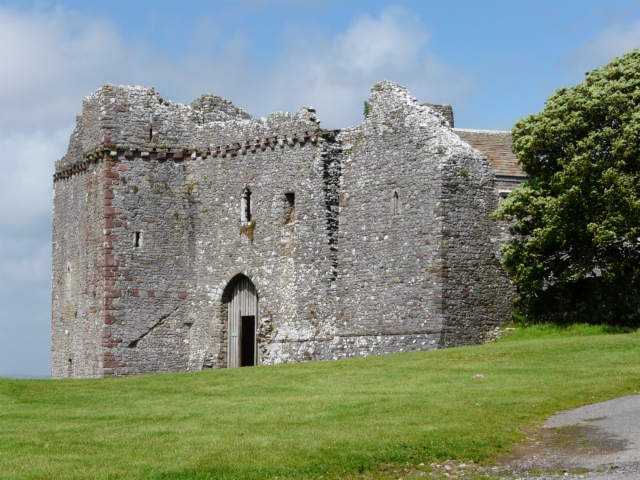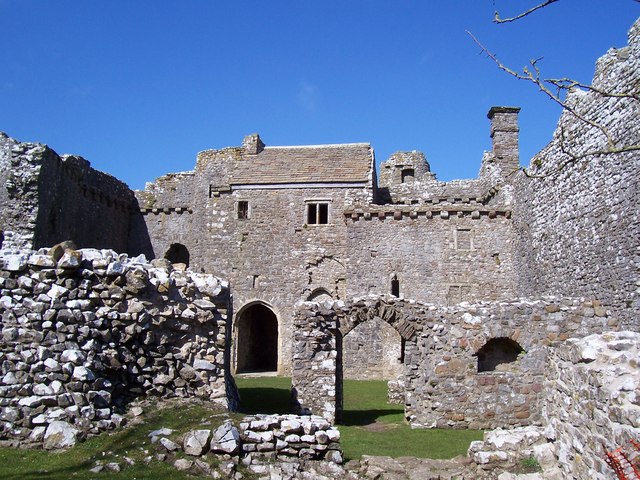Weobley Castle, Gower on:
[Wikipedia]
[Google]
[Amazon]


 Weobley Castle (pronounced "weblee "; cy, Castell Weble) is a 14th-century fortified
Weobley Castle (pronounced "weblee "; cy, Castell Weble) is a 14th-century fortified
in ''Historyextra'' website, accessed 25 March 2016
Cadw website, accessed 25 March 2016.Williams (1998), p. 24 It was then sold and subsequently leased to tenants until the 20th century, when the last owner, Emily Talbot, gave it to the state in 1911.Williams (1998), p. 29
Bibliography of sources related to Weobley Castle, WalesCadw's article
{{Gower Peninsula, state=collapsed Castles in Swansea Grade I listed buildings in Swansea Castle ruins in Wales Country houses in Wales Grade I listed castles in Wales


 Weobley Castle (pronounced "weblee "; cy, Castell Weble) is a 14th-century fortified
Weobley Castle (pronounced "weblee "; cy, Castell Weble) is a 14th-century fortified manor house
A manor house was historically the main residence of the lord of the manor. The house formed the administrative centre of a manor in the European feudal system; within its great hall were held the lord's manorial courts, communal meals w ...
on the Gower Peninsula
Gower ( cy, Gŵyr) or the Gower Peninsula () in southwest Wales, projects towards the Bristol Channel. It is the most westerly part of the historic county of Glamorgan. In 1956, the majority of Gower became the first area in the United Kingdom ...
, Wales
Wales ( cy, Cymru ) is a country that is part of the United Kingdom. It is bordered by England to the east, the Irish Sea to the north and west, the Celtic Sea to the south west and the Bristol Channel to the south. It had a population in ...
, in the care of Cadw. The castle overlooks Llanrhidian saltmarsh
A salt marsh or saltmarsh, also known as a coastal salt marsh or a tidal marsh, is a coastal ecosystem in the upper coastal intertidal zone between land and open saltwater or brackish water that is regularly flooded by the tides. It is dominated ...
es and the Loughor estuary
The River Loughor () ( cy, Afon Llwchwr) is a river in Wales which marks the border between Carmarthenshire and Swansea. The river is sourced from an underground lake at the Black Mountain emerging at the surface from Llygad Llwchwr which tran ...
.
The castle
The existing buildings were largely created between 1304 and 1327 by the de la Bere family. They consist of a gateway, a hall and kitchen, a chapel block and an east range, enclosing a courtyard, all now in a semi-ruinous state. The buildings are largely constructed ofrubble masonry
Rubble stone is rough, uneven building stone not laid in regular courses. It may fill the core of a wall which is faced with unit masonry such as brick or ashlar. Analogously, some medieval cathedral walls are outer shells of ashlar with an i ...
with window and door features of sandstone
Sandstone is a clastic sedimentary rock composed mainly of sand-sized (0.0625 to 2 mm) silicate grains. Sandstones comprise about 20–25% of all sedimentary rocks.
Most sandstone is composed of quartz or feldspar (both silicates ...
.Williams (1998), pp. 38–41.
The gateway, at the west of the castle, is framed to its north by the solar block, which contained the lord's private chamber, a latrine
A latrine is a toilet or an even simpler facility that is used as a toilet within a sanitation system. For example, it can be a communal trench in the earth in a camp to be used as emergency sanitation, a hole in the ground ( pit latrine), or ...
and a cellar space. To the south of the gateway is the so-called Cistern Turret, which is believed to have contained a cistern for rainwater storage; behind this is the South-West Tower, which was originally a separate building and may be the oldest part of the present structure. The gateway itself also included an additional living chamber in its upper storey. The northern range of the castle, including the hall, kitchen and porch leading from the inner courtyard, is the most substantial of the surviving sections. Features of the hall include a recess for the display of tapestry or panelling. This supports interpretations of the castle as primarily a wealthy residence rather than a military outpost. During excavations at the Chapel Block, fragments of a piscina
A piscina is a shallow basin placed near the altar of a church, or else in the vestry or sacristy, used for washing the communion vessels. The sacrarium is the drain itself. Anglicans usually refer to the basin, calling it a piscina. For Roman Ca ...
were discovered. The eastern range is more fragmentary that other parts, and much of it may never have been developed beyond the foundation stage during the ownership of the de la Beres.Williams (1998), pp. 39–43. Although most of the outer fortifications no longer exist, the remaining portions demonstrate that Weobley was well provided with guestrooms and facilities (including garderobe
Garderobe is a historic term for a room in a medieval castle. The ''Oxford English Dictionary'' gives as its first meaning a store-room for valuables, but also acknowledges "by extension, a private room, a bed-chamber; also a privy".
The word der ...
s). The building was extended later in the 14th century, including construction of the south porch."Weobley Castle, Swansea"in ''Historyextra'' website, accessed 25 March 2016
History
Until the 15th century the castle was the home of the de la Beres, originally stewards to William De Braose, Lord of Gower. In 1318 the castle is recorded by a deed signed there by Adam de la Bere.Williams (1998), p. 14 The castle was attacked and damaged by the forces of Owain Glyndŵr in the early 15th century, but most of the building was left standing. It is possible that John de la Bere (d. 1403) was a casualty of Glyndŵr's incursion.Williams (1998), pp. 20–21 SirRhys ap Thomas
Sir Rhys ap Thomas (1449–1525) was a Welsh soldier and landholder who rose to prominence during the Wars of the Roses, and was instrumental in the victory of Henry Tudor at the Battle of Bosworth. He remained a faithful supporter of Henry ...
became the owner towards the end of the 15th century; following the execution for treason of Rhys's grandson Rhys ap Gruffydd
Rhys ap Gruffydd, commonly known as The Lord Rhys, in Welsh ''Yr Arglwydd Rhys'' (c. 1132 – 28 April 1197) was the ruler of the Welsh kingdom of Deheubarth in south Wales from 1155 to 1197 and native Prince of Wales.
It was believed that he ...
in 1531, Weobley eventually reverted to the Crown in the person of King Henry VIII."Weobley Castle"Cadw website, accessed 25 March 2016.Williams (1998), p. 24 It was then sold and subsequently leased to tenants until the 20th century, when the last owner, Emily Talbot, gave it to the state in 1911.Williams (1998), p. 29
See also
*List of castles in Wales
Wales is sometimes called the "castle capital of the world" because of the large number of castles in a relatively small area. Wales had about 600 castles, of which over 100 are still standing, either as ruins or as restored buildings. The ...
*List of Cadw properties
Cadw is the historic environment service of the Welsh Government which manages historical buildings and ancient monuments in Wales.
, , Free, , Swansea, , Ilston, , Glamorganshire, , SS537898 , ,
, -
, Penarth-fawr, , Medieval House, , ?, , ...
*Castles in Great Britain and Ireland
Castles have played an important military, economic and social role in Great Britain and Ireland since their introduction following the Norman invasion of England in 1066. Although a small number of castles had been built in England in the 1050 ...
References
;Notes ;Sources *Williams, Diane M. (1998). ''Gower: A Guide to Ancient and Historic Monuments on The Gower Peninsula.'' Cardiff: CADW.External links
Bibliography of sources related to Weobley Castle, Wales
{{Gower Peninsula, state=collapsed Castles in Swansea Grade I listed buildings in Swansea Castle ruins in Wales Country houses in Wales Grade I listed castles in Wales